The world said goodbye to many influential people in 2023, one of them was Arctic Cat’s William G. Ness, 85, of River Falls, WI, who passed away on December 28, 2023. Arctic Cat’s Legend book chronicles some great history of Ness’ time at Arctic Enterprises and Arctco, and friend, Jim Dimmerman, shared some of my favorite SnoPro reunion stories HERE which included Ness. I never got to meet Bill personally, but appreciate all his contributions to the Arctic Cat brand. Bill was inducted into the International Snowmobile Hall of Fame in 1996. Ive included his ISHOF bio below and his well-written obituary immediately following. – Kale
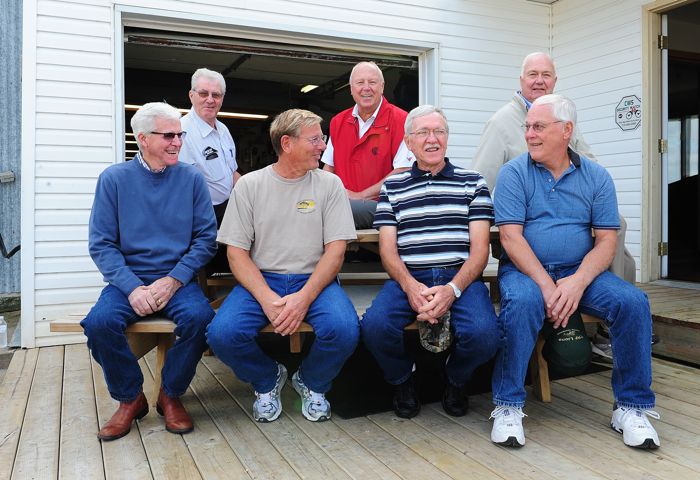
INTERNATIONAL SNOWMOBILE HALL OF FAME BIO (1996)
Ness joined Arctic Enterprises, Inc. in 1966 as Director of Engineering and served on that Company’s board as one of their five (5) Directors. Many new Arctic Cat model snowmobiles were made possible by the skills and expertise of Ness. He was also involved in the development and production of several of the famous Arctic Cat “dragsters” which served to enhance the publics’ awareness of the sport of snowmobiling. He was a leader in assisting the snowmobile industry’s establishment of safety standards for snowmobiles in the late 1960s and early 1970s. The set of rules eventually became the criteria for the present Snowmobile Safety Certification Program which is in effect today. His management skills and contacts with various manufacturers and suppliers were crucial in the formation of Arctco, Inc., manufacturer of Arctic Cat snowmobiles. During his association with both Arctic Enterprises and Arctco, Ness held various management positions including President and Chief Executive Officer of Arctco, Inc. Ness presently serves as a Director of the International Snowmobile Industry Association as well as the National Snowmobile Foundation. In addition to his involvement with Arctco, Inc. and snowmobile-related organizations, Ness presently serves as a director for numerous local, regional and state organizations. He has also garnered numerous awards resulting from his civic activities. In addition to remaining active in civic affairs, he presently manages and operates a 1600 acre grain farm. William G. Ness is an excellent example of the type of management person needed to make snowmobiling the recreational activity and industry it has became today.
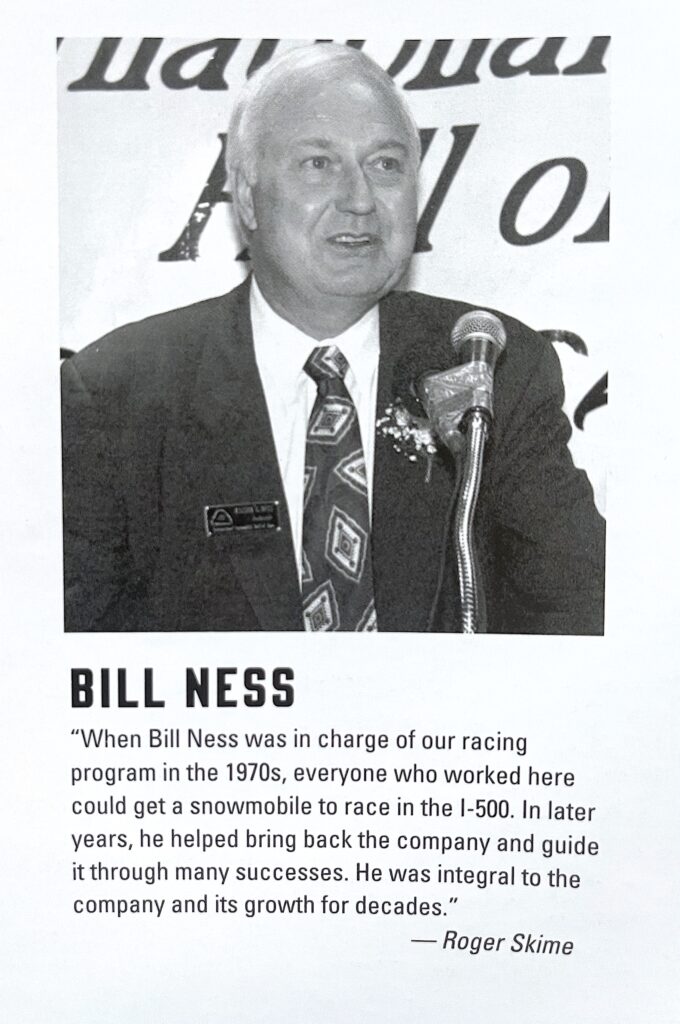
OBITUARY
“William Ness was born on May 22, 1938, to Lilly and George Ness. Billy, as he was known as a boy, grew up on a farm about seven miles northeast of the small town of Gully in Northwest Minnesota. On the farm, he helped raise all manner of livestock from chickens to hogs to beef cattle. While working with his dad on the tractors and farm implements, Billy not only mastered some colorful language (much to his mother’s chagrin) but developed a sharp mechanical aptitude that would serve him well in his future career in the snowmobile industry. Bill had many memorable moments growing up on the farm, which included the following:
- Before they had indoor plumbing, he would have to go to the outhouse in minus-whatever temperatures and use pages from a Sears & Roebuck catalog for purposes other than ordering merchandise. `
- On occasion, he and his sister, Norma, would take a shortcut to school through a pasture where they were frequently chased by an unwelcoming bull.
- Speaking of surly animals, they had a horse in the 1940s that was so mean, George aptly named it “Adolph.”
- On a bear hunt, Bill feared for his life—not from the bear—but from the other overeager hunters who sent bullets whizzing past him.
In her later years, Billy’s Grandma Ingaborg lived on the farm in a small cottage they named “Ma’s House.” Although Bill had fond memories of his grandma, she was apparently a sore loser when he would beat her at checkers. He and Grandma would tune into their favorite radio programs, including The Lone Ranger.
In his teen years, Billy became Gonvick High School’s star pitcher. He actually received a baseball scholarship for the University of North Dakota, but blew his arm out before he could take advantage of it.
Bill’s pursuit of an engineering degree at UND got off to a shaky start when he and a buddy’s surveying measurements were off by a depth of 10 feet. Luckily, he didn’t need to rely on a surveyor’s theodolite to pursue a degree in electrical engineering.
In 1959, his cousin Patsy set him and his friend up on a double date with two girls from her school. Before the date, Bill and his friend flipped a coin to see who would sit next to which girl. Fate put Bill in the seat next to a Michigan girl named Henrietta Goulette. Maybe it was the ambience of the fabulous Third Base supper club in Brooks, Minnesota. Maybe it was the peppermint schnapps they drank that night. Or maybe it was Henrietta’s good looks and charm. Whatever the cause, Bill fell head over heels for Henrietta (aka Hank) and proposed to her on the third date. They were married in Henrietta’s hometown of Iron Mountain on August 13, 1960, and went on to have three sons and two daughters.
In 1960, Bill began his career as an electrical engineer at Remington Rand Univac in St. Paul. In 1961, Lowell Swenson convinced him to move to Thief River Falls, Minnesota, and work as the chief engineer at the Dow Key Company, a coaxial relay manufacturer. In circa 1964, Swenson again talked Bill into making a leap of faith to a startup company called Arctic Cat, which began manufacturing a newfangled contraption called the snowmobile. It turns out that Arctic Cat caught lightning in a bottle, and snowmobiles sold like hotcakes. In 1967, Bill accepted the director of engineering and corporate director positions at Arctic Enterprises. During this time, he filed several patents, and many of Bill’s innovations are still used in snowmobiles today.
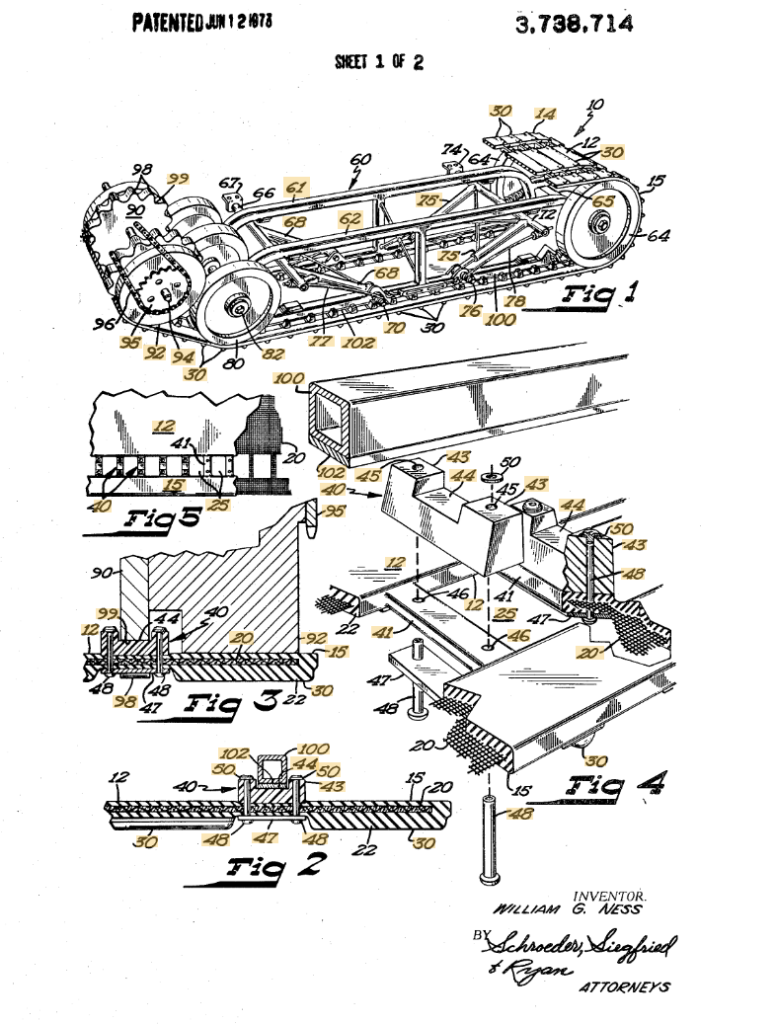
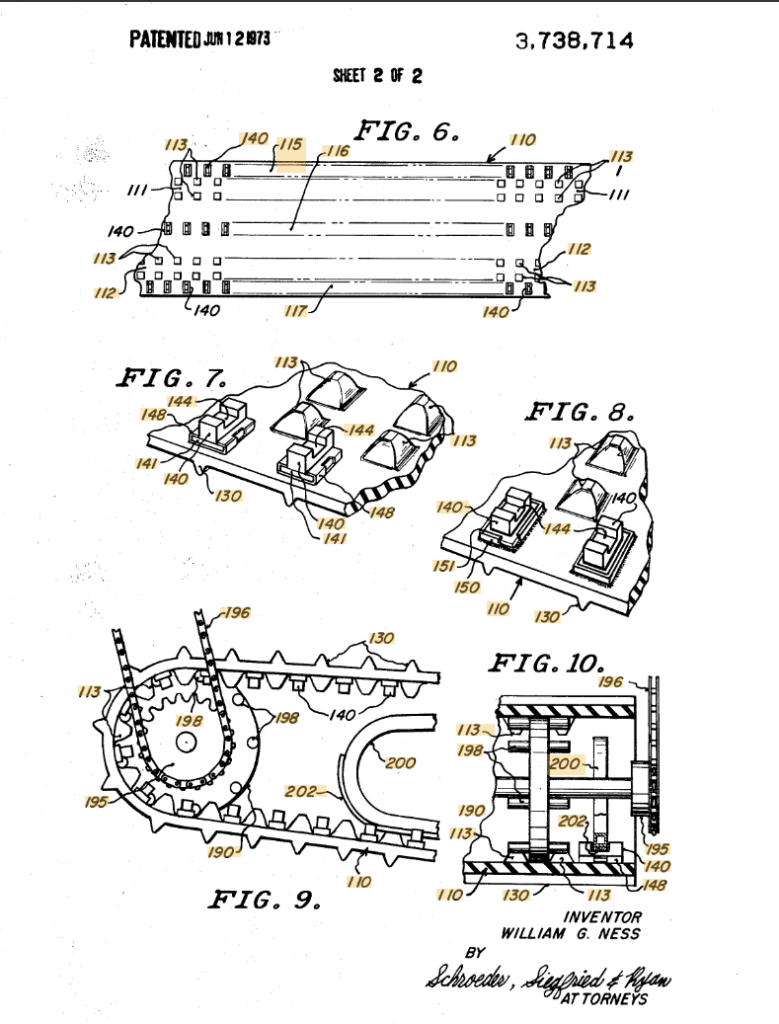
As part of his role in securing the parts supply chain and developing new markets, Bill travelled the world, visiting dozens of countries (more than 20 trips to Japan alone), no small ask for a man who suffered from severe claustrophobia and hated being trapped in a metal tube at 30,000 feet. While Bill was flying over Sydney on a flight to Hong Kong, the Quantas crew depressurized the plane, opened a hatch, and started tossing everything out. When Bill jokingly asked an attendant why they didn’t land the plane and look for the bomb, the attendant dryly replied, “Sorry, mate, it’s an altitude-controlled bomb.”
In addition to interesting destinations, Bill also met more than his share of famous and infamous people, ranging from U.S. Presidents to Saudi sheiks to Japanese industrialists to Chicago mobsters.
Despite all of Bill’s career successes, one of his finest and proudest professional moments rose out of the ashes of failure—the dark days following the bankruptcy of Arctic Enterprises. Bill remembered that bittersweet time: “Many of my friends, officers and the marketing people who had worked at Arctic Enterprises before its demise, had already left town for new careers. It was also rumored that Polaris was hiring the best engineers from the old company, and that the AEI plant, which had turned out so many quality sleds was slated for grain storage.” To add to the gloom, the economy was in the tank and interest rates were skyrocketing, causing snowmobile sales to sputter.
Despite these challenges, distributors, dealers, a trucking company, Thief River Falls business people and former employees had verbally committed to back a new company. However, there were many hurdles to overcome before the new company could begin production. Working out of former AEI President Lowell Swenson’s condo, which he provided rent-free, a small group of entrepreneurs from the old company, known as “The Boys from Thief River,” started hammering out the details and making the new company a reality. They worked for no salary for many months and received only a minimal salary the first year.
Thanks to the dedication of the employees and the first board of directors, Thief River Falls celebrated on August 1, 1983, as the first new generation of Arctic Cat snowmobiles came off the line.
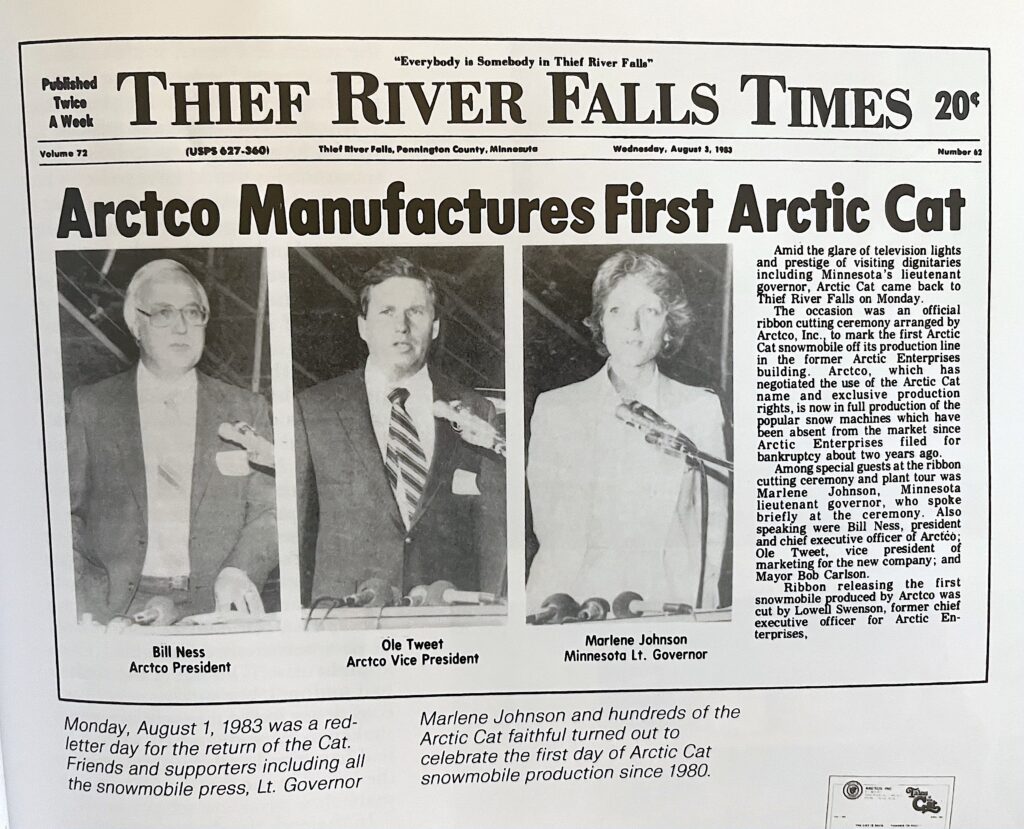
Years later, Bill recalled, “As I drive by the plant and see the hundreds of workers’ cars in the parking lot of Arctic Cat, I often remember that clear fall day in 1982 and I feel a great sense of satisfaction and pride in the people of Thief River Falls and the surrounding area who worked so hard to make it all possible.”
As if that wasn’t enough, Bill took on a second challenge as co-owner of Northern Woodwork, an architectural wood products manufacturer in Thief River Falls. By keeping the company in TRF, another 40 jobs were preserved in Northwestern Minnesota.
Throughout his career, Bill held various corporate and education directorships. Bill was honored with the Governor’s Award in Minnesota, was named Thief River Falls Outstanding Boss in 1974, received the Thief River Falls Chamber of Commerce President’s Award in 1989, was recognized by Snowmobile Magazine for being “1 of 25 who made a difference in the industry,” and was inducted into the Snowmobile Hall of Fame in 1996.
Although his instrumental role in bringing back the Cat was Bill’s proudest “professional accomplishment,” he would repeatedly tell people that his family was the thing that brought him the most pride. Following his semi-retirement (i.e., Bill never really fully retired), he loved spending time with family including:
- Farming with his son-in-law, Jim, and his grandsons.
- Snowmobiling and enjoying a bonfire with family out on his hunting land near Somerset, Wisconsin
- Boating on the St. Croix River near his second home in Hudson.
- Cooking out at Squaw Lake on a warm summer day.
- Deer hunting with his sons and grandsons, utilizing questionable Gully, Minnesota hunting strategies.
Bill never lost his wanderlust and continued to travel with Hank. It helped that their dear friend, Annette Bergan, was also a travel agent and talked them into multiple excursions that were not for the faint of heart. Moreover, Bill treated his family to memorable vacations through the years.
Ask people who knew Bill to describe him in one word, they would no doubt say, “generous.” Although Bill wanted to sneak out of the induction ceremony for the Knights of Columbus, he gave generously to a fund for retired clergy. He also made substantial donations to his alma mater UND and to research for Alzheimer’s, which afflicted his wife. Bill paid for his grandchildren’s higher education—no small feat in this age of jaw-dropping college costs. Bill hated cheapskate behavior and had little respect for men who took their whiskey bottle home instead of leaving it behind for the other party guests. Bill and Hank were the ultimate hosts, and throughout the 1970s, some of the biggest town soirees happened at the Ness home.
Bill was preceded in death by parents George and Lilly, sister Norma, infant siblings Janice and Glen, and niece Debbie. He is survived by beloved wife Henrietta; five children Greg (Karyn) Ness, Teresa (Jim) Mattison, Jon Ness, Jeff (Naomi) Ness, Rachel (Scott) Berger; 14 grandchildren and 7 great-grandchildren; and too many friends to be named here.
A memorial service will be held at 11 a.m. with visitation one hour prior and lunch afterward, Saturday, January 13, 2024, at O’Connell Family Funeral Home, 520 S. Eleventh Street, Hudson, WI 54016. His service will be live-streamed on O’Connell Family Funeral Homes website.
In lieu of flowers, please make a donation to the NW Minnesota Snowmobile Display Center at Peter Engelstad Pioneer Village, 825 Oakland Park Road, PO Box 127, Thief River Falls, MN 56701 or to a charity of your choice.”


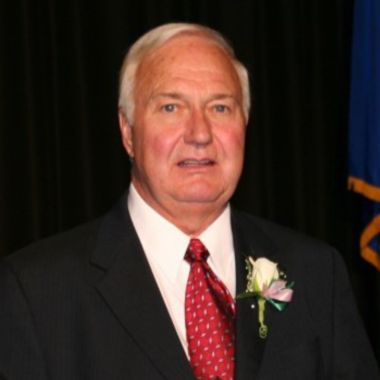
Never met the man, but knew of him from about the age of 15 when I received Ramstads “Legend” book. I remember reading that book hundreds of times every summer during my teen years. One day I went to Thief River for a tour of the plant. This was about 1992 or so. The lobby looked different then and there was a stairway off to the left side. I wanted to know what was up there but figured it was off limits to guests, especially teenaged kids. I stood at the bottom looking up wondering what sort of magic was up there when a lady asked me if I would like to take a look. It was just offices, but sitting in one of them was Bill Ness. I was completely star struck. I still remember that lady giggling at me acting much like a teenaged girl would seeing Taylor swift today.
Time passes on and one by one these legends pass as well. Rest In Peace Mr. Ness, you did well. Thank you for being a part of my and so many others lives
That’s an awesome story! Thanks for sharing!
There are only a few people who contributed more to the DNA of Arctic then did Bill Ness. Edger, Lowell, Roger, it’s a pretty short list. Thank you, Sir, for igniting a passion in me that has burned for well over 50 years. May you rest in peace.
These comments are wonderful!
It’s undeniable that snowmobilers carry passion for “their” brand. It’s no secret that we top this list. Why? There are countless reasons. Perhaps it’s the grit and determination that fuels Arctic Cat. It’s amazing that Mr. Ness and the others were able to stand up and put the company back on the skis. A big part of my life revolves around this company. I wouldn’t have it any other way. Mr. Ness, thank you!!
a great guy, met him at his induction to the Hall of Fame, was just visiting with his elementary school buddy Bud Bjornarra talking about how the big fires up in canada pushed all the bear down into the Gully area, and they were thick as raccoons! they both grew up together and some of the stories he told about them growing up together, Bud and I coach track together I had no idea they grew up and went to school in the same 1 room school house til 3rd grade, then Bill went to Gonvick and bud was across the road and went to Oklee great memories!
Sad to hear of this news, but thank you Kale for writing this up. Very cool history and sounds like an incredible man. My condolences to his family and friends.